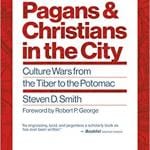In Steven D. Smith’s Pagans & Christians in the City: Culture Wars from the Tiber to the Potomac (Grand Rapids, MI: Eerdmans, 2018) there is one juicy anecdote that I think can be applied to so many debates about various groups in relation to the first Christians.
Smith takes issue with those who argue that there really wasn’t much of a difference between paganism and Christianity. He has in mind especially Guy Stroumsa’s argument in The End of Sacrifice that ancient Christianity was pluriform and “paganism” is something of a Christian creation as a socio-religious category. In counter-point, Smith deploys this winsome illustration:
As a logical matter, however, the inference from these descriptive observations to the conclusion that there was no inherent and fundamental conflict between paganism and Christianity, or that the ostensible differences between them were artificial and constructed, seems a non sequitur. One can imagine an analogous argument maintaining that although pet lovers have from time immemorial contrasted and debated the relative merits of “dogs” as opposed to “cats,” in reality the various sundry organisms placed under the label of “dog” are enormously diverse in size, color, and behavior. Moreover, no animals ever identified itself as a “dog:: the term and the category have been imposed entirely from the outside – bu humans. Same for cats. Consequently the supposed contrast between “dogs” and “cats” is profoundly misconceived. But this conclusion would be merely silly. Let us concede (although a philosophical realist might dispute the point) that “dog” and “cat,” like most or all other general terms and categories by which we understand and engage with the world – germs, planets, rivers, islands, cities, animals, plants, etc. – are devised by humans for the purpose of describing diverse particulars that usually would not and could not claim the terms for purposes of self-description (often because such entities – dogs, cats, germs, plants, rivers, etc. – do not and could not engage in self-description to begin with). The question is whether such terms and categories usefully help us to address real similarities and differences in the world. Similarly, although the point can always be debated, the widespread use of the categories “pagan” and “Christian” from late antiquity to the present at least suggest that the terms have proven useful in this way.” (pp. 104-5).
Very amusing. You could probably apply the same cats and dogs argument to those who deny the differences or self-definition among Jews and Christians or between Christians and Gnostics. I’m sure I’ve heard arguments that run like this:
– Christian Gnostics did not know that they were “Gnostics,” this label was given to them by their opponents, mostly by caricature and misrepresentation.
– The so-called Gnostics and proto-orthodox Christians were incredibly diverse.
– The differences between Gnostics and Christians is no greater than the differences between Gnostics themselves and between Christians themselves.
– Therefore, Christians and Gnostics were not really two different and distinguishable groups, but merely religious groups along the same religious spectrum.
Sound familiar?
Its a good reminder to be wary of arguments to the effect that certain entities were so diverse that they did not really exist.












